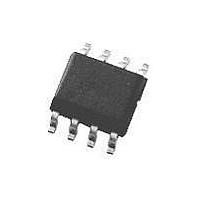LM2675M-5.0 National Semiconductor, LM2675M-5.0 Datasheet - Page 19

LM2675M-5.0
Manufacturer Part Number
LM2675M-5.0
Description
IC, STEP-DOWN REGULATOR, 8-SOIC
Manufacturer
National Semiconductor
Datasheet
1.LM2675M-5.0.pdf
(26 pages)
Specifications of LM2675M-5.0
Primary Input Voltage
12V
No. Of Outputs
1
Output Voltage
5V
Output Current
1A
No. Of Pins
8
Operating Temperature Range
-40°C To +125°C
Supply Voltage Range
6.5V To 40V
Termination Type
SMD
Lead Free Status / RoHS Status
Contains lead / RoHS non-compliant
Available stocks
Company
Part Number
Manufacturer
Quantity
Price
Company:
Part Number:
LM2675M-5.0
Manufacturer:
ns
Quantity:
4 000
Company:
Part Number:
LM2675M-5.0
Manufacturer:
NS
Quantity:
10
Part Number:
LM2675M-5.0
Manufacturer:
NS/国半
Quantity:
20 000
Company:
Part Number:
LM2675M-5.0/NOPB
Manufacturer:
NS
Quantity:
200
4. Catch Diode Selection (D1)
A. In normal operation, the average current of the catch diode is
the load current times the catch diode duty cycle, 1-D (D is the
switch duty cycle, which is approximately V
value of the catch diode average current occurs at the maximum
input voltage (minimum D). For normal operation, the catch
diode current rating must be at least 1.3 times greater than its
maximum average current. However, if the power supply design
must withstand a continuous output short, the diode should have
a current rating greater than the maximum current limit of the
LM2675. The most stressful condition for this diode is a shorted
output condition.
B. The reverse voltage rating of the diode should be at least
1.25 times the maximum input voltage.
C. Because of their fast switching speed and low forward
voltage drop, Schottky diodes provide the best performance and
efficiency. The Schottky diode must be located close to the
LM2675 using short leads and short printed circuit traces.
5. Input Capacitor (C
A low ESR aluminum or tantalum bypass capacitor is needed
between the input pin and ground to prevent large voltage
transients from appearing at the input. This capacitor should be
located close to the IC using short leads. In addition, the RMS
current rating of the input capacitor should be selected to be at
least
sheet must be checked to assure that this current rating is not
exceeded. The curves shown in Figure 14 show typical RMS
current ratings for several different aluminum electrolytic
capacitor values. A parallel connection of two or more
capacitors may be required to increase the total minimum RMS
current rating to suit the application requirements.
For an aluminum electrolytic capacitor, the voltage rating should
be at least 1.25 times the maximum input voltage. Caution must
be exercised if solid tantalum capacitors are used. The tantalum
capacitor voltage rating should be twice the maximum input
voltage. The tables in Figure 15 show the recommended
application voltage for AVX TPS and Sprague 594D tantalum
capacitors. It is also recommended that they be surge current
tested by the manufacturer. The TPS series available from AVX,
and the 593D and 594D series from Sprague are all surge
current tested. Another approach to minimize the surge current
stresses on the input capacitor is to add a small inductor in
series with the input supply line.
Use caution when using ceramic capacitors for input bypassing,
because it may cause severe ringing at the V
6. Boost Capacitor (C
This capacitor develops the necessary voltage to turn the switch
gate on fully. All applications should use a 0.01 µF, 50V ceramic
capacitor.
LM2675 Series Buck Regulator Design Procedure (Adjustable Output)
(Continued)
1
PROCEDURE (Adjustable Output Voltage Version)
⁄
2
the DC load current. The capacitor manufacturer data
IN
B
)
)
OUT
IN
/V
pin.
IN
). The largest
19
4. Catch Diode Selection (D1)
A. Refer to the table shown in Figure 12. Schottky diodes
provide the best performance, and in this example a 1A, 40V
Schottky diode would be a good choice. If the circuit must
withstand a continuous shorted output, a higher current (at least
2.2A) Schottky diode is recommended.
5. Input Capacitor (C
The important parameters for the input capacitor are the input
voltage rating and the RMS current rating. With a maximum
input voltage of 28V, an aluminum electrolytic capacitor with a
voltage rating of at least 35V (1.25 x V
The RMS current rating requirement for the input capacitor in a
buck regulator is approximately
example, with a 1A load, a capacitor with a RMS current rating
of at least 500 mA is needed. The curves shown in Figure 14
can be used to select an appropriate input capacitor. From the
curves, locate the 35V line and note which capacitor values
have RMS current ratings greater than 500 mA.
For a through hole design, a 330 µF/35V electrolytic capacitor
(Panasonic HFQ series, Nichicon PL, Sanyo MV-GX series or
equivalent) would be adequate. Other types or other
manufacturers’ capacitors can be used provided the RMS ripple
current ratings are adequate. Additionally, for a complete
surface mount design, electrolytic capacitors such as the Sanyo
CV-C or CV-BS, and the Nichicon WF or UR and the NIC
Components NACZ series could be considered.
For surface mount designs, solid tantalum capacitors can be
used, but caution must be exercised with regard to the capacitor
surge current rating and voltage rating. In this example,
checking Figure 15, and the Sprague 594D series datasheet, a
Sprague 594D 15 µF, 50V capacitor is adequate.
6. Boost Capacitor (C
For this application, and all applications, use a 0.01 µF, 50V
ceramic capacitor.
EXAMPLE (Adjustable Output Voltage Version)
IN
B
)
)
1
⁄
2
the DC load current. In this
IN
) would be needed.
www.national.com














